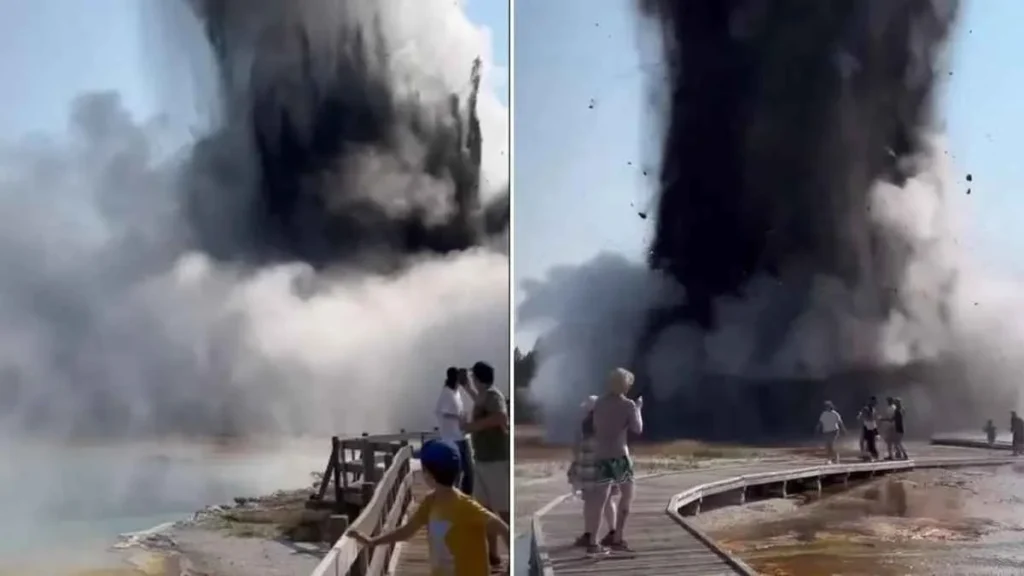Yellowstone National Park’s Biscuit Basin experienced a dramatic hydrothermal explosion recently, which led to significant damage to the boardwalk and frightened visitors. This comprehensive guide will delve into the event’s details, the nature of hydrothermal explosions, and their implications.
The Incident at Biscuit Basin
Date and Location: On a Tuesday morning around 10 a.m., a hydrothermal explosion occurred in the Biscuit Basin thermal area, located approximately two miles northwest of Old Faithful. The explosion seemed to originate near the Black Diamond Pool.
Impact: The explosion was powerful enough to damage the boardwalk. Fortunately, no injuries were reported, although the incident caused several visitors to run for safety.
Response: The U.S. Geological Survey (USGS) promptly closed Biscuit Basin, including its boardwalks and parking lots, to ensure visitor safety while investigations commenced.
Current Volcanic Activity: Despite the explosion, the USGS reported that volcanic activity in the Yellowstone region remains at normal levels.

Capturing the Explosion
A video shared on Facebook by Vlada March documented the explosion. March described the event as happening right before her eyes, with debris hitting her mother but leaving everyone safe. Her post expressed disbelief and gratitude for their safety.
Understanding Hydrothermal Explosions
Nature of Hydrothermal Explosions: Hydrothermal explosions occur when hot water in a volcanic system suddenly converts to steam in a confined space. This rapid expansion, caused by a sudden drop in pressure, results in explosive eruptions that can create craters.
Frequency and Locations: According to Michael Poland, the scientist-in-charge at Yellowstone Volcano Observatory, Yellowstone is a global hotspot for these geologic hazards, which occur a few times annually. Other significant sites for hydrothermal activity include New Zealand, Iceland, and Chile.

Historical Context of Hydrothermal Explosions
Significant Craters: Yellowstone’s northeast region, near Yellowstone Lake, is home to three of the largest known hydrothermal explosion craters:
- Mary Bay: The largest, formed 13,000 years ago, is a mile and a half wide.
- Turbid Lake: A mile-wide crater formed 9,400 years ago.
- Elliott’s Crater: Nearly half a mile wide, formed 8,000 years ago.
Expectations for Future Explosions: Craters the size of a football field are expected to form every few hundred years. Despite their unpredictability, scientists are researching methods to forecast these events.
Human Impact and Observations
Safety Concerns: While no fatalities or injuries have been recorded from hydrothermal explosions, they pose significant risks due to the potential for ejecting rocks, mud, and boiling water.
Notable Explosions:
- Ear Spring (2018): This explosion near Old Faithful ejected rocks and historical debris, including a Hamm’s beer can and other vintage items.
- Porkchop Geyser (1989): Observers watched this geyser’s water spout grow from 30 to 100 feet before it exploded, creating a 30-foot crater and altering the geyser’s shape.
- Biscuit Basin (2009): Another explosion occurred in this area on May 17, 2009.
Research and Forecasting: Scientists continue to investigate the potential for predicting hydrothermal explosions. However, as Michael Poland indicates, the capability to forecast these events remains uncertain.

Conclusion
Hydrothermal explosions, while less renowned than volcanic eruptions and earthquakes, represent significant geological hazards, especially in areas like Yellowstone National Park. The recent event at Biscuit Basin underscores the importance of ongoing research and preparedness to ensure visitor safety and enhance our understanding of these natural phenomena.





